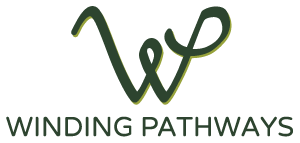by Winding Pathways | May 29, 2025 | Chickens
Sillier and Smarter Than You Think
Many believe chickens are noisy “bird brains”, yet we have learned from and enjoy chicken wisdom. Our small flock lives in a modest coop in the backyard. In addition to the fresh eggs they lay, they give us education and often a laugh through their antics.
Recently, a hen taught us that chickens can be silly as they demonstrate devotion and intelligence. It started when one of our hens became broody.
Broodiness is when a bird decides to be a mom. She fluffs up her feathers, eats little, stops laying eggs, changes her vocabulary, and spends hours in a nest. We decided to try something.
Golf Ball Trickery
We put a new nest in a separate coop, lined it with soft pine shavings, and filled it with golf balls. Yes, golf balls. When we showed the nest to the hen, she moved right in and kept the golf balls toasty warm. That’s not too smart, but shows persistence.
How Long Will It Take To Incubate Golf Balls?
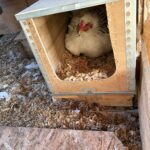
A private nest for a broody hen.
It takes a chicken egg 21 days of incubation to hatch chicks, but hens, like most animals, can’t count. And, hens do not know the difference between “fake eggs” and real ones. She would sit for weeks trying to hatch golf balls. After she sat for about three weeks, we bought six chicks at a farm store and kept them in their tiny travel box until dark. Then, with only a flashlight to help guide him, Rich reached under the broody hen, retrieved the golf balls, and replaced them with the six balls of enthusiastic peeping fuzz. Baby chicks.
Would she adopt them?
We didn’t know if the hen would “wake up” from her trance and adopt the chicks. So, twice in the night, Rich woke and went out to check. Success! The new mama hen had gently tucked the babies under her soft warm feathers. The adoption was successful, saving us the trouble of brooding chicks.
Compassionate Mother Hen
We marvel at the outstanding care the new mom gives her babies. We learned that these admirable chicken traits are not always shared by people.
- The chicks aren’t biologically hers. Doesn’t matter. She’s a devoted mother.
- Some chicks are black. Others white. Still others have different colored feathers. Doesn’t matter. They’re tiny babies that need care that she readily gives.
Our mama hen practices Diversity, Equity, and Inclusion. Admirable trails, all.
She Just Knows How to Raise Chicks
Our mother hen was hatched in an incubator and raised in a brooder without the benefit of a mom. Yet, without child-rearing resources of books, friends, and the Internet, she just knew how to give her babies good care. It’s an admirable instinct.
She does more than just keep her babies warm. With her varied vocabulary of clucks and peeps, she shows the chicks where food is. She scolds the babies from time to time with a harsh screech sound. They listen and obey. She’s a wonderful and caring mother.
-
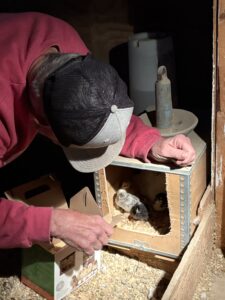
-
Placing After Dark
-
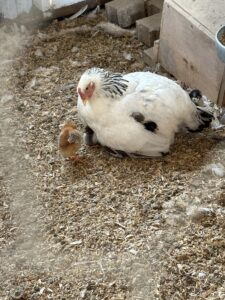
-
Adopted chicks
-
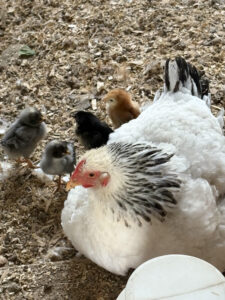
-
Happy mama.
A Valuable Lesson For All
Broodiness can be a bother. When sitting on eggs and caring for babies, a hen won’t lay eggs, and often a family needs eggs more than chicks. However, watching the process of chicken reproduction is a fascinating and fun learning experience.
by Winding Pathways | May 22, 2025 | Ruminations
Post Three – Three to Eight Weeks and Beyond
(Think Buzz Lightyear – All is Possible)
Mummy was Right!
Here I am! Starting to feel better. Thinking I can do things. And I can. However, as friends near and far remind me, “Take things easily.”
As kids, when we’d get up in the morning feeling kind of crummy, Mum always said, “Wash up, get dressed, have breakfast, make your bed. Then, we will decide if you need to stay home.” Most of the time we were good to go.
I found the same with this period of post-surgery. This link has fabulous insights on post surgery care.
Below is a rhythm I found helpful.
Usually, some movement, healthy food, and getting dressed did the trick. My body is stiff, I feel sweaty from hours in bed, I’m hungry and sometimes ‘hangry’. I started off doing the “baby” leg exercises important following back surgery. Then, I’d get the other tasks done. Doing these few routine tasks settled me in. Adding any needed OTC medication helped. Then, rest. Yep. Back to lying down but not in bed. That is too easy. And, I want bed to be for sleep not slumming. So, I kept items near the couch and would lie down for about 20 minutes. Alternating ice and heat on various complaining body parts helped. Then, up to do a few simple activities.
After a time, I incorporated light house work like dishes, tidying up spaces, computer work to keep in touch and pay bills, walking the driveway horseshoe loop for exercise. Always mindful to avoid bending, twisting, over-reaching. The vertebrae and hardware need to fuse.
Remember to send TY notes to folks. I would do a few each day. I kept a list and postcards pre-addressed and stamped to send. And, found the Jacquie Lawson ecards helpful to send to people who unexpectedly helped.
Connect with people a few times a week to lessen feelings of isolation. I’d ask people close by to help arrange visits. From a distance, I simply sent periodic, and sometimes idiotic, emails to people. Usually, I got idiotic replies back that made me smile and laugh.
Here is one from another childhood friend: “Thanks for the update–keep ’em coming. I was going to ask how things were going and I’m glad you seem to be hanging in. HMMM perhaps coming up with strategies to complete every day activities will be good for your brain! When my yoga teacher introduces a new pose that sounds really wonky, I call it “Yoga for Alzheimers prevention.””
Moving
Walk on safe surfaces several times a day. On warm days, I could walk the horseshoe drive a few times each day. Then, I’d increase the distances. Some days, I simply did less. The upward trajectory of movement and health is the goal. Physical therapy may not start for several more weeks. I did the simple but important leg exercises as per the medical booklet.
My walking mantra is: Heel-toe. Low belly up. Shoulders back. Chin parallel to the walking surface. Use your peripheral vision. Cane as a guide and as per an Occupational Therapy friend, Increase your Stride.
The six-week checkup was positive, and the reminder to limit bending/twisting was good. Lifting about 15 pounds is OK. One and a half gallons of milk is about 15 pounds. I still do morning preparation and chores, then rest. After about 6.5 weeks, I successfully put on compression socks by myself. So, Rich’s morning task is about done.
The cane for going out and about is helpful. Around the house, I manage all right. And, reachers! Keep them! So, I bought several.
None Of Us Is As Smart As All Of Us
Years ago, when trying to figure out something, a Kansas colleague, Lila King, stated, “None of us is as smart as all of us.” By golly, we figured out a sticky problem. That mantra has proved helpful many times since. How do I get things done? Ask! People want to help.
Continuing to have and accept help is important in these weeks and beyond. I found that I tired easily, so I rested. The prioritized list of “things to do that are helpful” made it easy for friends and family to visit and pitch in, which they all did graciously. And my saying, “Yes, thank you!” helped all around. What are some of these tasks?
Having family come help healed more than just the tasks. Great company and was reassuring.
Friends and family measured the space for new shower curtains, researched the best sites to order from, and helped install. Hotel-quality and style make freshening shower curtains easier without awkwardly removing the rod.
The family helped wash the insides of windows where the painter had inadvertently left smudges and install screens for the season.
Our daughter pulled the paint cans from storage so the painter could finish one small project. Our son and son-in-law hung pictures and screens, split wood, and were attentive od my getting into and out of the car. They all did many small deeds of kindness. Rich was close by and helpful over the many weeks.
After six weeks, the toenails were long, so our daughter suggested a pedicure so that a professional could trim them. How lovely to have someone nurture the feet. I didn’t think about that as an option. None of us is as smart as all of us.
An East Coast friend mentioned ways to care for the surgical scars to loosen up tissue and avoid binding problems in the future. None of us is as smart as all of us.
When I mentioned that the doctor visit showed high blood pressure, a friend said, “Wait five minutes and do again.” Yes, of course. When we first come to a visit we have been walking, are nervous and breathing shallowly. Deep breaths and resting a few minutes reveals normal blood pressure. Why didn’t the nurse do this? Hmmmm. None of us is as smart as all of us.
Soup Cubes to the rescue! Again, from our daughter, I learned about these handy ways to freeze food, pop out the back, place in labeled freezer zip-locks, label, and pull out when we needed a quick meal. This is helpful now that the MealTrain is done. None of us is as smart as all of us.
So many more acts of kindness, generously shared.
Time for Pleasure
Not everything was work. A puzzle kept us entertained and our daughter is so strategic on putting it together. While I rested, family took walks on the many trails that now link the area. They met with long-time friends and met new people. Coffee shops rock and are new to them, so Cedar Rapids has changed positively in that regard. Nice meals out. Chats in the living room and on the back deck in nice weather.
Giving Back
What Can We Do When We Feel We Can Do So Little? Healing completely takes time. Many people have helped over the weeks. And continue to do so. At first I thought I could not do much to help. What could I do with such limitations? Well, it turns out to be quite a bit.
I asked our daughter if she would share her music. She brought her accordion along and played songs for a friend who had recently been injured. We sang – sort of – and laughed. A hospice nurse colleague asked me to work with a patient and family with healing energy. An honor, indeed. A labyrinth colleague and friend accidentally double-scheduled a time. She asked if I could do the one-hour Veriditas Friday ZOOM hand-held finger labyrinth walk. Veriditas has offered this activity EVERY Friday since the Pandemic began in the US in earnest in March 2020. My theme was easy: “What Can We Do When We Feel We Can Do So Little?” Four continents were represented as over 50 people worldwide zoomed in and shared their perspectives. Another honor to give back. And, so it goes as we receive so we share – The Ketchuan philosophy. From you I receive to you I give. Together we share and from this we live. A Unitarian Universalist hymn. Inclusivity.
Well, moving on here. As I wrote in the beginning, take whatever is useful and leave the rest behind. These were simply my observations of recovery which will take about a year to be fully realized.
by Winding Pathways | May 15, 2025 | Preparedness, Ruminations
*Apologies to Ben Franklin*
It’s funny how quotes get attributed to people. Franklin might not have actually said the quote above, but he did have the right idea with his quote: in the 1737 Poor Richard’s Almanack: “A penny saved is two pence clear.” When you save something today, it likely will grow in worth over time.
We are on the far side of age 75 and enjoying financial security that has resulted from a lifetime of careful spending, good advice, and a bit of luck. A penny saved here and there added up.
We’re not financial experts so this is just how a lifetime of money management enabled us to emerge into good money health despite years of lean income.
Over many years of talking with people facing financial stress we often hear them say, “I need to find a job that pays better.” Well, you might not need to do that. You simply need to spend less and perhaps live in a more affordable geographic location. Dr. Laurie Santos, professor at Yale University, hosts a series on the Science of Well Being. She also hosts a six-week course, the Science of Well-Being for Teens. Participants look closely at their lifestyles and where they spend time and money that drain them, causing them to think they need more. Often it is not true. It’s a great course to take online.
Our Background
We worked in the nonprofit sector, which provided slim salaries and sparse benefits. We liked what we did so never felt compelled to change jobs for better pay. Rather than seek higher pay we used what money we had efficiently.
Financial Philosophy
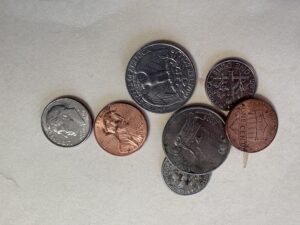
A Penny Saved is a Penny Earned
Our basic financial philosophy is that however much money a person earns, if he/she spends a little less and consistently invests the difference, financial health increases. Of course, that was partly back in the day when financial institutions gave better interest return on money customers deposited.
Decades Long Strategy
Here’s what we’ve done for over a half century to be financially secure.
- Avoided compulsive, ego spending. Keeping up with the Joneses costs money.
- Developed a long-term relationship with our bank and brokerage as partners. Their advice is free.
- Avoided paying rent and borrowing money. Yup, we drove old cars we could pay cash for and regularly put money in the bank. This earned us interest and avoided loan interest. Then, when we needed to buy a car, we withdrew money and paid cash. We rented apartments briefly but invested in a house purchase. Because we live frugally, we were able to pay off a mortgage early. Now our housing costs are utilities, taxes, and maintenance. No monthly rent or mortgage! It’s a pay-as-we-go philosophy. Granted, we did not “enjoy” some of the exotic trips or coolest stuff and we are better off for it.
- Avoided voluntary taxes. People complain they don’t want to pay taxes. (Benefits exist to paying legitimate taxes) Then, what do they do? Some buy tobacco, alcohol, and gamble.
By doing so, they pay self-imposed high taxes and often end up with health issues. We’ve never smoked, don’t gamble, and enjoy a beer or a sip of wine occasionally. A pack of cigarettes in Iowa costs about $9. If we each smoked two packs a day, our daily cost would be $36. That’s over $13,000 a year. If we’d done this for our 50-year marriage we’d have spent far more on tobacco than to buy our home.
- Embraced life cycle cost. For example, it’s common for the least expensive refrigerator to consume the most electricity. Life cycle cost means figuring out what an object will cost during its likely lifespan. Usually paying slightly more upfront for a well-made, efficient device saves chunks of money over time. Energy efficiency saves money! BTW, ditch the inefficient refrigerator or freezer you’ve held on to. Recycle it. Likely you don’t need all the extra stored food. Your electric bill will go down and you have more space in your home.
- Embraced inexpensive recreation. People often carefully calculate the cost for business and home functional items, then spend ridiculously on recreation.
Hobbies
Rich’s hobbies are reading (library books are free), walking, birding, and fishing. He also scrounges and crafts items like bird feeders.
Fishing’s a good example. It can be expensive but doesn’t have to be. A cheap rod and reel costs about 30 bucks and won’t last long. A better one costs about $100 and is durable and efficient, but the very best is around $500. Sticking with the $100 model is the most cost efficient…..and he catches fish from an ancient rowboat purchased at a garage sale. In contrast, an expensive powerboat and electronics need insurance, storage, maintenance, and fuel. Not needed for catching fish.
- We love gardening, which helps lower food costs. Even a small patio can support vegetables you may enjoy.
- Avoid being nickel and dimed to death. It sounds cheap. Only eight dollars a month for a streaming service. $96 a year. Multiply that by six streaming services and that $96 a month costs close to $576 a year. All sorts of other things that seem cheap per month put a constant drain on finances. A few bucks here. A few bucks there. They add up!
- Use our credit card carefully and always pay off the balance on time to avoid interest costs.
Final Words
The upshot is, most people do NOT need to earn more money, they need to learn to use what they have wisely.
We spend carefully yet live richly and have avoided the terror of a heavy debt burden. Our financial strategy has led us in a good direction and we believe it may help others to achieve the same result.
by Winding Pathways | May 1, 2025 | Birds, Flowers/Grasses, Nature
A woodland stroll is outstanding in any season but is best during May’s first ten days. We always marvel at nature’s fleeting changes that happen swiftly.
Why Early May
Late April and early May are when ephemeral flowers revel in their time in the sun. That long word “ephemeral” means a short time. There’s a brief time in late April through about mid-May when the air and soil are warm but trees haven’t yet leafed out. So, sunlight streams through still naked branches to reach the ground.
Bloodroot, trout lily, anemone, Dutchman’s breeches, ginger, trillium, and May apples, among many of the woodland flowers, take advantage of this window of sunshine. They grow amazingly fast, bloom for a short time, and then seem to disappear for the rest of the year. They are there but hard to see and not in bloom during summer’s heat and winter’s chill.
-
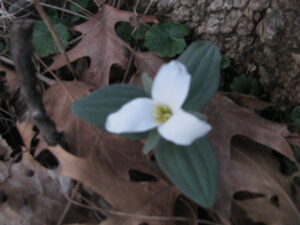
-
An early bloomer
-
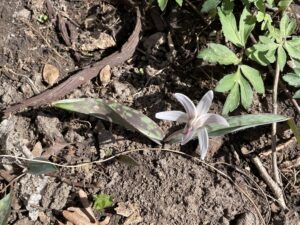
-
Trout Lily can form carpets in dappled shade.
-
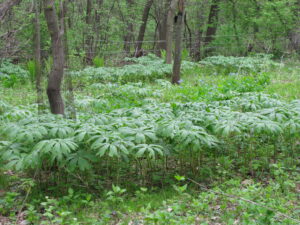
-
Mayapples carpet the forest floor.
-
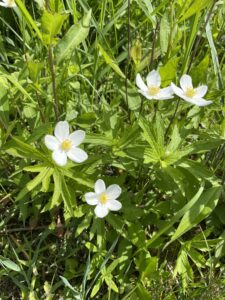
-
A sunny center surrounded by white petals.
-
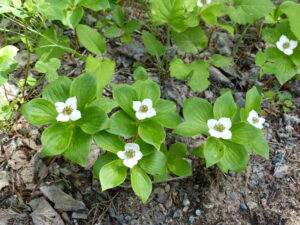
-
Bunchberry forms a lush, carpet on moist soils.
-
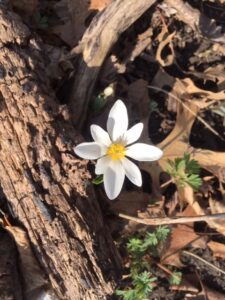
-
When broken, the stem oozes a reddish sap.
Other Delights
Enjoying wildflowers is only one of early May’s woodland delights. Another is birds.
Many of them are, like wildflowers, ephemeral but in a different way. They are migrants en route from points way south to breeding areas up north. For only a few days, often in early May, they linger to feed, rest, and sing before continuing their journey.
We always look forward to seeing migrating birds on their way north and others that come north to nest near our home. Flowers are easy to find. They can’t hide. Birds can, and often many fascinating birds are hard to spot but easy to hear as they sing in what seems like springtime joy.
-
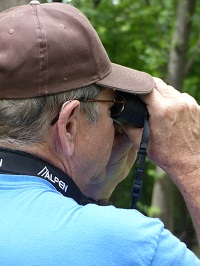
-
Bird watching is again a joy with hearing aids.
-
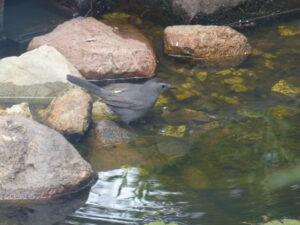
-
A catbird drinks by a pool.
-
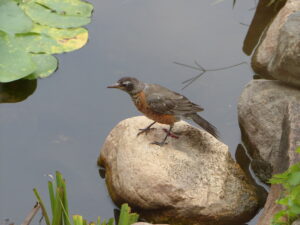
-
Keeping a wary eye, the robin cautiously gets a drink.
-

-
Hummingbirds zoom up, down, and sideways all summer. Then, head south.
-
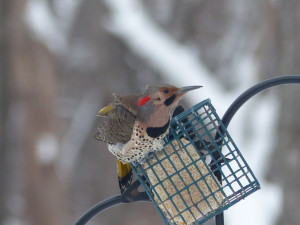
-
Winter is tough on birds so keep your feeders full.
-
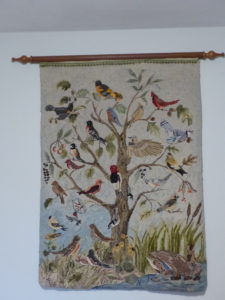
-
A hooked rug by Yvonne Fellows
Modern Technology Helps
Identifying flower and bird species is a fun activity that modern technology has made relatively simple. We use phone apps to help identify plants and birds. Many are free.
Plants: SEEK is amazing. SEEK is part of an electronic world called iNaturalist. It works for many domestic plants as well as wild ones. Load the app, open it when encountering an unknown plant, take a photo, and SEEK can usually accurately identify it.
Birds: We love the Cornell University Lab of Ornithology’s Merlin Bird ID app. It includes a sound identification tool. So, when we’re in the woods, prairie or marsh and we hear birdsong we can’t identify, we turn on Merlin and select the sound feature. It identifies what’s singing. Merlin also includes photos and information on each species.
We hope you take in the annual show. Early May is the best time to be outside. Enjoy and remember.
by Winding Pathways | Apr 17, 2025 | Geology/Weather, Nature, Travel/Columns
Quincy Warmth
After a short walk through deep snow in the bitter cold, we entered a dimly lit tunnel. As we stepped into Quincy Mine’s long tunnel we were surrounded by warmth. Well, the warmth was relative. Outside it was below zero but inside the tunnel was a balmy 43 degrees.
We visited Quincy Mine in Michigan’s Keweenaw Peninsula in frigid February, but if we had been there on a blistering hot August day the mine’s interior temperature would be a delightfully cool 43 degrees. It’s always that temperature in that tunnel deep underground.
No matter the season, the Keweenaw Peninsula is a fun place to visit. It juts upward into Lake Superior. Lake effect snow piles deeply each winter, but in summer the Lake sends cool breezes inland.
“We Do Winter Well”
This claim by Visit Keweenaw advocates is no exaggeration. Residents navigate steep, snowy streets with aplomb. Some travel by snowmobiles to work, take a short spin during lunch breaks, and motor on home after work. They dress warmly and relish the cold. The area welcomes winter visitors who enjoy downhill and cross-country skiing, snowshoeing, snowmobiling, shopping, and meals of grilled lake whitefish and locally made pasties. More about them later. Broom and ice hockey regionally and at the Michigan Technological University draw in families by the dozens. The Huskies, sometimes known as the “Stick Huskies” – think hockey – compete, creating fabulous ice sculptures that dot the campus and area.
-
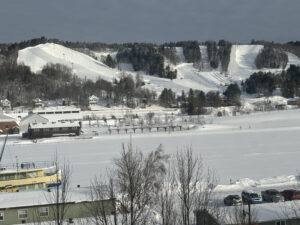
-
Trail groomers started before dawn to groom trils.
-
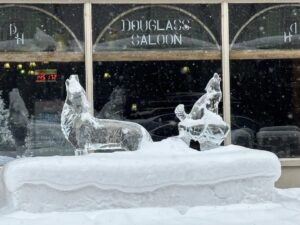
-
ice sculptures dot the town and campus.
-
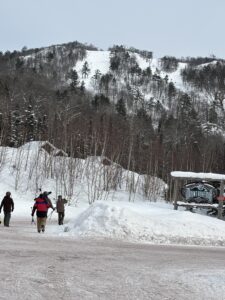
-
BoHo is an ungroomed Black Diamond ski area.
Shopping and dining are equally fun in summer, and warmer weather offers boating, swimming, fishing, and sightseeing. During warm months, visitors can book a ride on boats taking them to the distant Isle Royale National Park.
What and Where Is the Keweenaw?
The Keweenaw is actually a peninsula on a peninsula. It’s attached to the relatively wild Upper Peninsula, but interestingly it’s no longer a peninsula at all. Originally a natural inlet extended most of the way across the peninsula’s base. To facilitate shipping, land was removed, extending the inlet into a canal and making the Keweenaw an island. Today the main towns of Houghton and Hancock face each other across the Portage Canal and are separated by one of the world’s largest lift bridges. In summer, dozens of boats motor by, including some large ones.
Copper Country
For us touring Quincy Mine was a visit highlight. For nearly a century it produced thousands of tons of copper that helped America electrify. Quincy is only one of several that once operated in the area but they all were abandoned when less expensive, open pit mining got established in Utah.
Today Quincy Mine welcomes people to tour its towering surface features that pulled ore up from upwards of 9,000 feet underground. Down that far, the temperatures were blistering 80+ degrees. It was amazing, but we were more fascinated deep down in a mine tunnel when our guide, Clayton Gomez, stopped our small group and doused the electric lights, leaving only one candle to illuminate the vast darkness. “This is how much light miners had as they used muscles to drill into the rock.”
“They’d then stuff blasting power into the hole and set it off. Afterward they loaded the loose stone in carts and pushed it to a shaft where a lift carried it to the surface. It was dangerous and hard work. They earned $2 for a 10-hour shift,” he added. Some of us tried to muscle the heavy cart to little avail.
Initially, the demand was for highly skilled workers in teams of three. One held an iron bar, two alternated hitting the end. In between the one holding the bar, turned it slightly so it would not lodge in the rock. At best this would be dangerous. Done by candle light, required cooperation and skills. Mining innovations changed that. Men worked alone so if an accident happened, they might not be found for hours.
Clayton ended our tour with this thought: “Holes in the ground all we have left to tell the story.” But, he pointed out, copper remains such an important part of our lives. Computers, cars, cell phones.
-
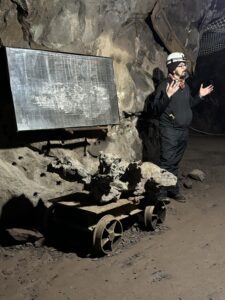
-
Clayton and mine shaft diagram.
-
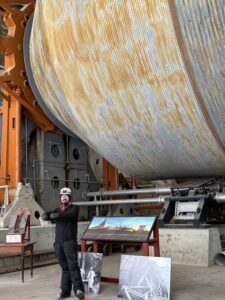
-
Mine shaft drum.
-
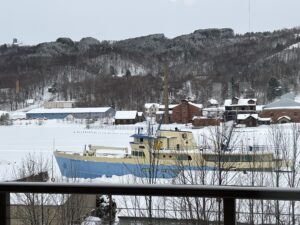
-
Canal. Park Service Boat. Ski run. Quincy Mine Shaft on far hill.
Who Were the Early Settlers and Miners?
The workers, immigrants from the Cornish region, were small, tough, wiry. In the paternalist setting where they received housing and a few amenities, if one got injured or killed, the family was forced to move. After a sweat-soaking shift, the men would change into clothes and step into the sub-freezing weather and trundle home. Only to repeat the process the next day.
Other immigrants from northern Europe arrived and took to the cold, snowy climate. Today skiing and ski jumping are hallmarks of the Nordic heritage. Evidence of the Daughters of Italy, Sons of Norway, Canadian, Finnish and Cornish ancestry highlight the area.
Although mining is now long gone, a delicious traditional food remains. A meat and vegetable pie called a pasty is tasty, nutritious, and portable. (Say the word with a short “a” so as not to confuse with an accoutrement of pole dancers.) Miners would bring this traditional Cornish meal with them as they descended into the pit and enjoy it for lunch.
Many local stores and cafes now sell pasties and we ate several during our stay.
We also enjoyed taking a sauna at Takka Saunas on a frigid day. After sitting in a steamy small sauna building, we dashed out. Marion did the traditional Finnish tradition of laying down in the snow making a snow angel. Rich only stood barefoot in the snow. A sauna part of Finnish culture is fun in any season.
-
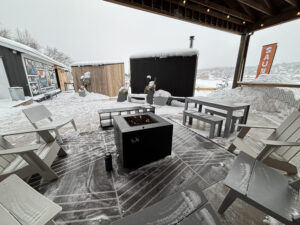
-
Amenities abound
-
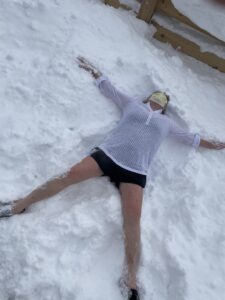
-
Roll in the snow or plunge into cold water.
Keweenaw Mountain Lodge
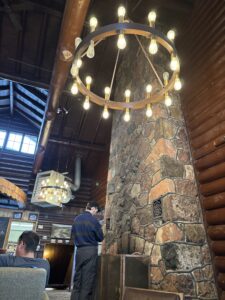
Dark sky and slow travel haven.
Part of our adventure was finding respite at the Keweenaw Mountain Lodge. Some in our group snowshoed. Others lounged in the rustic ambiance. Adjusting to “slow travel” and learning more about the dark sky options. As the lodge owner stated, “We lean into what is authentic and unique.” Heated cabins and groomed trails beckoned. The chef creates delicious picnic baskets and the Tasting Post features a “slow dining” experience. On clear nights the aurora is spectacular.
Jibba Jabba
We went to the Keweenaw for the annual Jibba Jabba Railjam. Dozens of young competitors climbed the manufactured hill in downtown Houghton and took turns sluicing down the steep slope, riding rails, swooshing through the tunnel, and spinning to a stop in front of hundreds of enthusiastic spectators. For days ahead, city crews had hauled in and packed snow at just the right angle on one of the steep streets that are hallmarks of Houghton. The result? Fast speed and thrilling rides down the course.
-
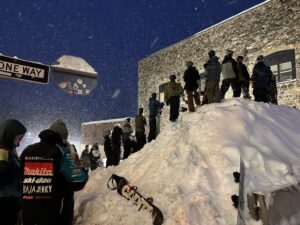
-
Snowy wait
-
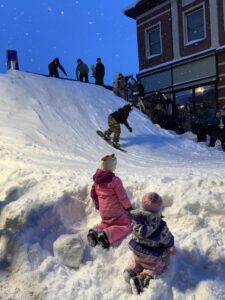
-
Excitement
-
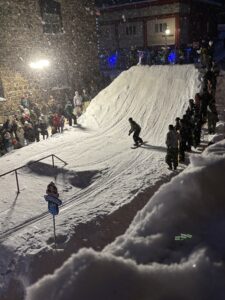
-
Snowy event
Getting There
Five hundred miles north and slightly East is the thumb of the Keweenaw that juts into Lake Superior. Houghton, MI, is Eastern time so we lost an hour. We took two days going, stopping to walk a special labyrinth in Westfield, WI, and overnight at Rhinelander, taking in the Hodag Hunt. These mythological creatures frequent the town and purportedly the nearby forests. We did encounter several in town, which was fun. Eagle River is worth a stop with a terrific coffee shop and amazing annual ice sculptures.
-
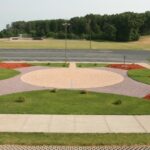
-
The Labyrinth we built as Andy’s Memorial.
-
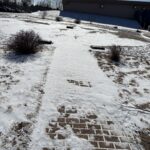
-
Special labyrinth
After two hours of snowy and scary driving we found clear pavement. Good thing we have advances in car technology and road safety. We stayed on our side of the road because of the center and side rumble strips. No “good ‘ole days” for us. We prefer safe cars and roadways.
We drove back in an easy day as we gained an hour.
-
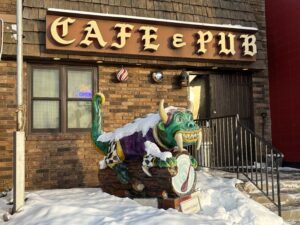
-
Welcome!
-
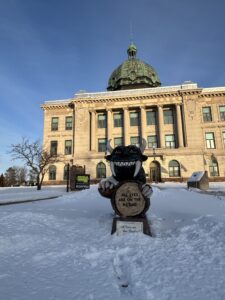
-
Hodag hunt
-
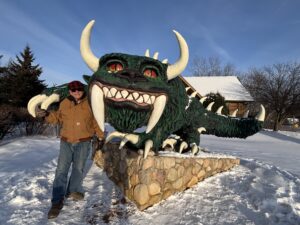
-
A beaten path to the visitor center Hodag.
For information on what to do at the Keweenaw and where to stay check out Visit Keweenaw.
We were there during winter’s icy grip but a future visit during summer’s warmth is in our plans.

